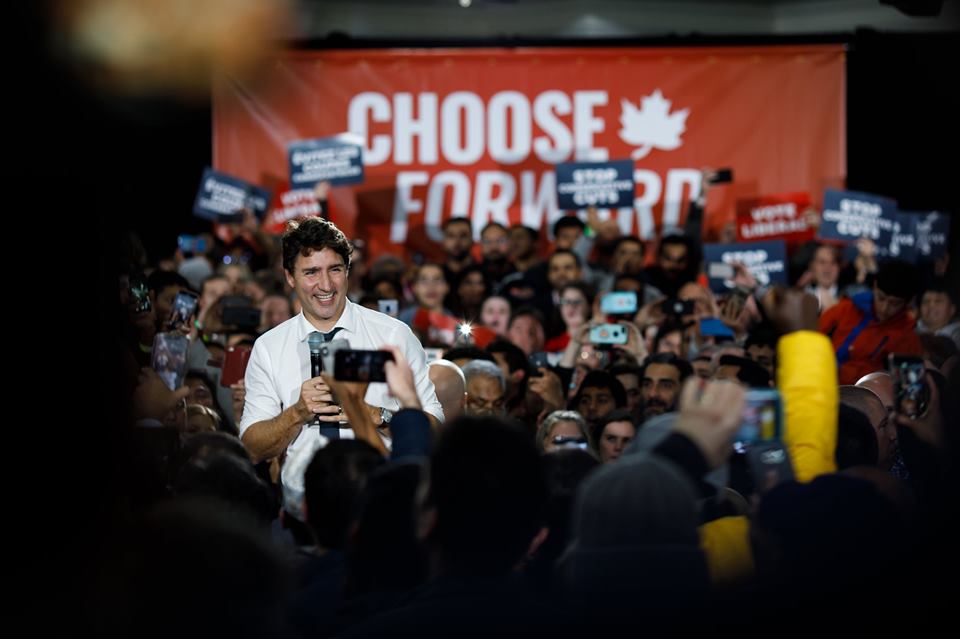After a short and difficult election campaign, the Liberals won 157 seats, 27 fewer than in the 2015 election but enough to form a minority government.
The Liberals can form a voting majority (of 170 or more) by wooing the NDP, which won 24 seats, down from 44 in 2105.
Liberal, NDP, and Green party voters together accounted for over 55 per cent of the popular vote, a message that Justin Trudeau would be silly to ignore in putting together a budget and a legislative agenda.
The Conservatives managed to improve their standings in the House of Commons, going to 121 seats, up from 99, but will remain the official Opposition. They can take solace from outpolling the Liberals overall, 34.4 per cent to 33.1 per cent.
With 99 per cent of polls reporting, the voter turnout looked to be about 65 per cent, down from 69 per cent in 2015.
While unhappiness with the performance of the prime minister resulted in rejection of all Trudeau Liberals in Alberta and Saskatchewan, and losing six of the 17 seats won in B.C., the Liberals were strong enough in Atlantic Canada, Quebec and Ontario to retain power in a minority Parliament.
Rather than focus on its achievements as a four-year majority government and its plans for the future, the Liberals ran a campaign detailing provincial and Harper Conservative cuts to spending, and asking Canadians to compare them to the Conservative alternative.
In contrast to the NDP, which called on Canadians to beware of voting for Liberals who failed to live up to their promises, Trudeau warned Canadians to be afraid of a Conservative government — that would keep its promises.
The revelation by The Globe and Mail that Conservative Leader Scheer, a 15-year veteran of the House of Commons, held joint U.S. citizenship, had registered for U.S. selective military service, had applied for a U.S. passport, and filed U.S. income tax yearly did nothing to help the Conservative campaign.
After a surge that caught observers by surprise, the Bloc Québécois led by Yves-François Blanchet regained party status, winning 32 Quebec seats.
The Liberal loss of their parliamentary majority came down to “Caquistan,” a nickname for the areas outside Montreal that gave the François Legault-led CAQ (Coalition pour l’avenir du Québec) its majority victory in the 2018 Quebec elections.
Federally, a year later, these CAQ areas returned Bloc MPs.
The NDP lost 15 of the 16 Quebec seats won in 2015; only Alexandre Boulerice, in Montreal, managed to retain his seat. The Conservatives held on to their 10 seats in the Quebec City area.
The Bloc Québécois was unabashed in its support for the CAQ, including Bill 21, which restricts the freedom of individuals who wear headscarves, turbans or skullcaps to serve the public in positions of authority such as teaching or police work.
More importantly, the Bloc was a convenient place for Quebecers unimpressed by Trudeau’s commitment to the French language or to Quebec identity, or to contracts for Quebec shipbuilding or to support for SNC-Lavalin employees and pensioners, to park their votes.
Not until his last speech did Bloc Leader Blanchet go off message to reveal that he would use his parliamentary perch to advocate for Quebec independence and not limit himself to defending Quebec interests in Ottawa.
The story of the NDP was captured in the Twitter hashtag #UpRiSingh.
Despite finishing the 2015 election with 44 seats, the mainstream media wrote off the NDP at the outset of election 2019 as a party without a hope or a future.
When election 2019 started, the NDP trailed the Green party in both Quebec and B.C., provinces where combined it had won 30 seats in 2015.
The turnaround in party fortunes was mostly on the shoulders of leader Jagmeet Singh.
Just as his poor showing as the new party leader came as a surprise to party observers, once campaign 2019 began, his ability to shine in debates with other leaders was welcomed by party faithful, and made journalists and broadcasters pay some attention.
The NDP has a diminished presence in the House of Commons, but Liberal-NDP agreement could produce specific measures such as national pharmacare or renewed support for co-op and public housing, or climate change initiatives.
The Green party with its caucus of three should be interested in supporting the government on climate change.
It is unlikely the Liberals will adopt the NDP wealth tax proposal.
Trudeau can always reach out to the Conservatives to enact a tax cut or to gain support for the Trans Mountain pipeline expansion.
Like his father in 1972, Justin Trudeau went from a first-term majority to a second-term minority.
With a diminished caucus, Pierre Trudeau warmed to ideas put forward by NDP leader David Lewis and took them on in exchange for continued NDP support.
Facing a similar situation, will Justin Trudeau look to work with Jagmeet Singh?
Duncan Cameron is president emeritus of rabble.ca and writes a weekly column on politics and current affairs.
Image: Justin Trudeau/Facebook



